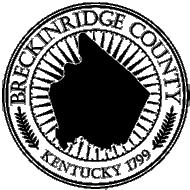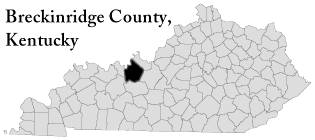 |
USGenWeb Archives Project Breckinridge County, Kentucky |
 |
 |
 |
 |
 |
USGenWeb Archives Project Breckinridge County, Kentucky |
 |
 |
 |
 |
THESE
ARCHIVES BUILT BY YOUR
CONTRIBUTIONS.
PLEASE CONTRIBUTE TODAY!
New
Easy to use Submission
Forms!
This Page Updated Monday, 11-Apr-2022 20:27:49 EDT
| BRECKINRIDGE COUNTY, KENTUCKY |
| AREA COMMUNTIES OF THE PAST AND PRESENT |
| KIRK |
The Kirk settlement is one of the older settlements in the
county. It lies
some four miles southwest of Hardinsburg,
between Planters Hall and the county seat.
The Kirk
community is situated on a ridge east of Clover Creek and west of
Tuels Creek,
which separates it from the Kingswood community.
Some of the earlier settlers of this community and indeed
the
county, were the Withers, DeHavens, Jarboes, Sheerans,
Mattinglys, Millers, Tauls, Coomes, McGarys, and Rhodes.
Soon after the trouble with the Indians subsided and the
people
began to move out away from the fort, this fertile, well-timbered
ridge between Tuels and Clover Creeks became inhabited.
Being
isolated or without any communication with the rest of the world,
it
did not gain its identity as a separate community until the
railroad ran through the community in 1890.
The main line of the Louisville, Henderson, and St. Louis
Railroad was completed from Irvington to Fordsville.
The
track was completed from Irvington to Cloverport in 1887. Immediately
afterward, the five McCracken brothers from New York
began work on the spur line, as it was called, that ran from
Irvington to Fordsville. The
track was completed as far as
Kirk and the
first train ran through the community in the spring of 1888.
It was in this year that Mr. W. K. Withers saw the need
and
opportunity
for a business at this point and built a store.
Soon after this first store was built, other families
moved
nearby and it was not long before a post office was needed and
the Kirk community was on the map.
The town was called Kirk at the suggestion of Mr. Harvey
McCracken, who was president of the railroad at that time.
Why he called it
Kirk, I do not know.
Pete Sheeran was the second businessman in town. He built a
small store in the south end of town and later bought
out Mr. Withers store and moved the two stores together.
In 1890, Pete Sheeran and Mr. Lon Jarboe built a large
tobacco
warehouse where they bought and priced tobacco to be
shipped to market on the new railroad.
It is hard for s to
realize what this railroad meant to these isolated communities in
1890. Prior
to this date any tobacco or other farm produce, or incoming
merchandise had to be hauled overland in a wagon from Cloverport.
These two men, Pete Sheeran and Lon Jarboe, also operated
a stave
mill for the Cincinnati Cooperage Company, and dealt
in Lumber. Between
1890, and the end of World War I most of
the remaining good in this community found its way to market over
the old Branch Line Railroad.
During the 1890’s, Dock Farrow built his home in
town and
sold groceries and goods in one room of his home.
The town was not without medical aid.
Dr. Cosby was there
at that time and a short time later Dr. Milton Board
moved into the community and put up his office building.
In 1898, Cyrus Miller built a large store in town which
was run
by Marcus Mattingly. He
sold general merchandise
and all kinds of farm machinery.
During this time, when business was booming, Sheeran and
Jarboe
had enlarged their store. They
were handling dry
goods, groceries, hardware, furniture, machinery, buggies, and
wagons; also mens’ suits and a millinery department. Their
wrapping
paper advertised that they handled anything a person needed from
the cradle to the grave. And
truly they did. One
could go to
Kirk and buy a bundle of diapers and safety pins or a coffin and
shroud.
By 1900, Kirk had a livery stable and two blacksmith
shops, one
of which was run by Hiram Winchell who later sold to
Robert Scroggins. The
other one was owned by Mr. George
Mattingly, who had a combination blacksmith and woodworking
shop. Sometime
later the Scroggins’ shop was operated
by Raymond Mattingly.
Kirk was no different than all the rest of the communities
in the
county in respect to their religious life.
In 1896,
the patrons of the Oakland School built a Methodist Church which
was dedicated in August of that year.
The pastor was
Brother
Crowe who served both the New Oakland Church and Hardinsburg.
This church lasted for thirty-two years.
Then in 1928,
with better roads and better means of transportation, the
Methodist Conference sold the building to J. W. Withers and Son,
and the
congregation moved their membership to Hardinsburg.
Later,
the Corinth Baptist Church at McQuady bought the benches, which
are still in use in that church. The
old church building is
still standing but is used for a tobacco barn.
It was not until 1935, that the inter-county seat road
leading
from Hardinsburg to Fordsville was graveled, connecting Kirk
with the rest of the world by a means other than the railroad.
Mr. Hugh Johnson of Davies County was the contractor and
the
crushed limestone was quarried on Mrs. Monarch’s farm near
Kirk. This and
other rock roads in the county soon spelled
“doom”
for the railroad which brought life into the county some fifty
years earlier.
There was a rather large one-room county school in town
where all
eight grades were taught. This
was consolidated
with Hardinsburg and the school was discontinued in 1927.
For a few years Kirk had a gristmill but it did not last
long and
later Alvin Miller opened a store in the building.
Pete Sheeran sold his interest in his store to Marcus
Mattingly
and moved to Meade County and bought a farm.
The
store was then continued under the name of Mattingly and Jarboe.
By this time most of the industry was gone. The warehouse
was discontinued by 1911, and the stave mill disappeared in 1915.
In the Cyrus Miller building, Alvin Miller and Will
DeHaven had a
store which lasted about two years; thus, leaving Mattingly
and Jarboe the only store in town.
In 1929, a new type of business opened up in Kirk that
looked
like it would have been a permanent fixture.
Mrs.
A. H. Withers and Mrs. Agnes Dodd started a studio of handiwork.
This occupied two cottages and employed from twenty to a
hundred workers. During
the winter months they usually had
over one hundred women working with a monthly pay roll of
$3,000. This studio
turned out all kinds of quilted and
handmade articles such as baby clothes, negligees, draperies,
quilts, and
the like. They
employed 14 sales women in 14 different
states and one in Honolulu, one on Cape Cod, and a booth in the
Drake
Hotel in Chicago, and a shop in the Brown Hotel in Louisville.
This business brought a lot of badly needed money into the
Kirk
community these four years, but in March of 1930, it
burned down with about a sixty thousand dollar loss to the
owners. In 1929,
the sales had amounted to over $75,000.
At this same time the store of Mattingly and Jarboe was
sold to
J. R. Mattingly and Son. Later
Gus Mattingly
bought the store and it burned down.
Paul Mattingly later built a store on the highway but sold
it to
J. M. Hinton. The
store opened by Alvin Miller
was sold to Mr. A. H. Withers who sold out four months later to
Mason Embry. In
1952, Mr. Embry sold to Lonnie Lucas
who sold to Jess Carwile who still owns it.
The post office has stayed with the town since the start. The
first postmaster was W. K. Withers.
Since
then the office has been held by Pete Sheeran, Marcus Mattingly,
J. E. Monarch, Mrs. Alvin Miller, J. R. Mattingly, Ruth M.
Withers,
Shellie Embry, who died while holding office, and Katherine
Hinton who held the office until it was discontinued in 1965.
The Kirk community on its ridge between Clover and Tuels
Creeks,
indeed all the county between old Morton Town
and Hardinsburg, is unsurpassed for beauty anywhere this side of
the Bluegrass region.